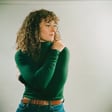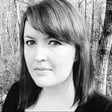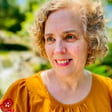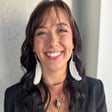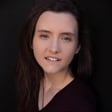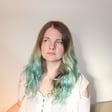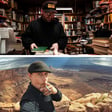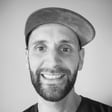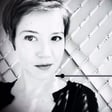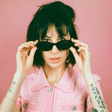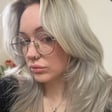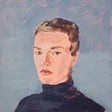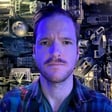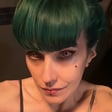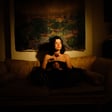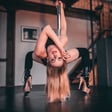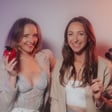Introduction to 'Something Rather Than Nothing'
00:00:00
Speaker
You are listening to something rather than nothing. Creator and host Ken Volante. Editor and producer Peter Bauer.
00:00:17
Speaker
This is Ken Volante with the Something Rather Than Nothing podcast. And this episode, we have Emily Samosky, who's an artist originally from Ohio, and she's teaching and doing art in Washington state. And I'm very happy to welcome you, Emily, to the show. Welcome to Something Rather Than Nothing.
Importance of Creativity in Childhood
00:00:39
Speaker
Thanks, Ken. I appreciate it. Thanks so much for having me. Yeah. And your art.
00:00:48
Speaker
caught my eye, and I know it's on display, and I like to talk about your pieces, but prior to that, a question I ask guests is, were you an artist when you were born?
00:01:04
Speaker
I think I was, but I don't know that I would put the label on it. I liked to make things for as long as I can remember. As a kid, I was always coloring and drawing.
00:01:19
Speaker
But in a way, I kind of feel like everyone is that kind of like creative artist as a kid. I think that everybody's is kind of involved in that in some way.
00:01:34
Speaker
Prior to coming to Washington and to getting my MFA, I taught elementary school art for a year. And I taught kindergarten through second grade. And it was super exciting to see just how excited and just amazed the kids were with using art supplies and making things. And it was almost like what they did or what they drew or made out of clay.
00:02:03
Speaker
became real to them.
Cultivating Creativity in Schools
00:02:05
Speaker
And I just thought that was so exciting that we don't really see that a whole lot as we get older, in terms of people really embracing their creativity and what they can make. And, you know, so it just got me thinking about that, that I feel super lucky that I was able to kind of hold on to that as I got older and to really embrace that. But yeah, in a way, I think that we're all kind of drawn to make things in some way or another.
00:02:33
Speaker
Yeah, it emerges a big theme as I've talked to creators during the show, just the sense of what children want to do, are capable of doing, are capable of expressing, and how that's either amplified or stunted, existent or non-existent, and then kind of a relationship that you have is
00:03:00
Speaker
you know, as you get older and you were right there within it, you know, around kids and doing that teaching. And I've just been sensitive to that area of the potential of kids. And what do you think that we do? Like, what did you see that we do where we could cultivate that more, whether it's in the schools or whatever, but like, how do we do that? Because there's not enough and you and I know it.
00:03:26
Speaker
Yeah I think that I mean so much in our school system is based on standardization and you know creating things that are measurable in terms of goals for students and in order to do that you have to have you know things have to be kind of like cut and dry and there's not much room for asking questions and taking risks and
00:03:50
Speaker
exploring the world. And I think that if we're going to cultivate that in kids, we need to start taking away that this is right and this is wrong. This is the correct answer. Being able to just
00:04:07
Speaker
to ask questions and to not know the answer and to feel okay about that and yeah I think that that's kind of where it starts but yeah I mean I think that even after out of school you know a lot of even a lot of jobs you kind of get in your role and you you do what you're supposed to do and there's not a whole lot of room
00:04:30
Speaker
to explore beyond that. We kind of live in this very rigid structure, or a lot of people do, I think, where you go to school, you get your degree, you get a job.
Exploring Mixed Media Art
00:04:42
Speaker
And you don't really have the freedom to think that there's anything other than doing that. But yeah, I mean, I think that just that asking questions and exploring and at a young age is something that should be encouraged more in the school systems, for sure.
00:05:00
Speaker
Yeah, yeah. I wanted to ask to dig right in about, you know, you're you creating your work I've heard you describe your process and you teach as well I was wondering if you could talk about
00:05:17
Speaker
the work that you have on exhibit and Walla Walla just as far as how you I see you know mixed media a collage but can you can you kind of bring in the listeners to what that looks like what it is how you make it
00:05:33
Speaker
Sure, yeah, so that work, currently I have six mixed media paintings on display and they're pretty large. They're seven feet by eight feet. So when you walk up to them, you kind of feel like it's, at least what I was hoping to create was this immersive experience where it doesn't necessarily feel like a painting on a wall as much as a window into a different kind of space.
00:06:01
Speaker
And so I work with mixed media, mostly paint and collage. So I use anything from spray paint, airbrush, acrylic, mostly oil paint and collaging digital prints into that. So I embed the collage material and I layer that up with the other painted and drawing materials so that there becomes this
00:06:29
Speaker
kind of a confusion between what material, like I try to integrate them so much that sometimes it clearly represents itself as what it is, but other times there's more ambiguity and it just kind of complicates the visual language of the work.
00:06:48
Speaker
But these paintings are all based around the idea of interiority or looking at interior spaces like the inner nature of our lives through domestic spaces.
Art as Personal Expression
00:07:02
Speaker
So each painting is kind of it's framed around a specific kind of space or a room.
00:07:09
Speaker
But I do work with representation and abstractions. So I see my work as bridging between a lot of different things that there are some aspects of it that help to orient you and to provide some kind of understanding of the space. But then some areas just kind of dissolve into this abstract space where there becomes more room for interpretation in terms of
00:07:37
Speaker
some of the subject matter that I'm using, each one works with different ideas of how we construct our space to connections between domestic spaces and natural spaces. So each one, I kind of look into these different aspects of our lives and just the complexity of really what it means to be a person in the world. Yeah, so that's kind of, that's an ongoing body of work.
00:08:06
Speaker
I'm working a little bit more on a smaller scale at the moment. I kind of wanted to take a break from kind of shifting the lens from that large environmental scale to now kind of using a smaller framework to explore similar ideas in different kinds of environments. So that's something that I'm kind of shifting and working through right now. But yeah, that kind of just gives a little bit of a summary of what I have here in Walla Walla.
00:08:36
Speaker
Yeah and I like, and thank you for that, I like the thinking about space and interior space and like I see you know aspects of like symbolism or if something's mundane or not mundane and you try to claim that and I also like what you had to say about the materiality of the not knowing what it is because philosophers love those questions is it like what is it constructed of and it's like sometimes I know when I painted
00:09:02
Speaker
And honestly, there's too many plastics and chemicals that are combining in ways I really don't know that something else is formed where you don't know what it is, right? That's kind of a cool spot. I wanted to ask you, and we're talking with Emily Samosky, artist. Emily,
00:09:27
Speaker
big question, I want to do one up front a bit here, what is art? I think that it's something that it's hard to define beyond just being some form of visual expression or visual communication,
Impact of Moving and Pandemic on Art
00:09:49
Speaker
I think that it's up to the individual to determine what it is that they're making and if they consider it art or what they're looking at. I see art as, I guess more broadly, as a way for us to kind of get out of that routine, the mundane or the repetitive nature of
00:10:12
Speaker
the world that we live in, you know, I think that whether through making or through looking at art, it can help us to just something that maybe invokes a sense of wonder or questioning or causes you to take a step back and just reflect and think. So yeah, I mean, I see it as serving a purpose beyond just
00:10:37
Speaker
expressing how you feel or how you engage or process the world. But yeah, I think it can just offer us a way to kind of break out of some of the repetitive nature of our lives.
00:10:53
Speaker
Yeah, I wanted to ask a question in particular to you. I've lived in different areas of country. I'm familiar with the Midwest and not as much with Ohio, which is sometimes called the Midwest, but some of your experience there as far as what you're around, as far as art and what you see. And coming to a place when I moved out here seemed very different as far as aesthetics and how things look and art look.
00:11:20
Speaker
Could you give some of your impressions as far as moving from the area to where you are now and just how you see the art that's around you or the art world in that way? Yeah, that's an interesting question because
00:11:35
Speaker
When I moved here just about a year ago, it was, you know, we've been in the pandemic ever since I moved out here. So I don't feel like I have a full picture yet of what it feels like to live in Washington State or in Walla Walla.
00:11:53
Speaker
But it is interesting, though, just having a change of landscape, because living in Northeast Ohio, it's very flat, you know, there's not a whole lot of variety in terms of landscape, in terms of art.
00:12:10
Speaker
I actually feel pretty lucky that there was a pretty exciting art world in Cleveland and in Akron, which is closer to where I lived. So there were a lot of opportunities to see art and to be inspired and to
00:12:29
Speaker
to keep wanting to pursue this as something that I saw in the world. But yeah, and again, because of the pandemic, it's hard to really say what that's like here because we've just started to have art openings again and to start to see things in person.
00:12:48
Speaker
But I am excited once we can start to travel a little bit more to be able to, you know, being in driving distance from, you know, Seattle and Portland and to be able to go and see galleries and museums again.
00:13:03
Speaker
But yeah, you know, I think that it's whenever you have some kind of life change or a shift in location in your environment, for me at least, you know, the few times that I've switched studios or apartments, I feel like there is some kind of shift that happens in my work.
Artistic Journey and Personal Influences
00:13:22
Speaker
And I do feel that that's happening right now. This past year I've been working on
00:13:28
Speaker
I mentioned kind of shifting the lens of my work a little bit. And I see that as reflecting where I'm living, but also the times that we're living in right now, too. Yeah, so I'm excited to see where that goes once I get that flushed out a little bit more.
00:13:43
Speaker
Yeah and I like that and you know I mean it's a shift but I've talked to a lot of artists about shift of the conditions that you're in. Do you have access to a studio or can you perform live you know live performers? You can't like really perform at all in a lot of circumstances so significant impacts is kind of what you do and how you do it during the course of the
00:14:08
Speaker
the pandemic, which podcast stretched over. But it sounds like right now like an exciting step, kind of like step into seeing like, okay, what is going on in this new environment that I'm in that's kind of strange and new, right? Exactly. Yeah. Yeah. I got another bigger question for you. What or who made you who you are? So I think
00:14:38
Speaker
Going back to growing up, I really do think that a lot of the decisions that I made that informed who I am came from
00:14:50
Speaker
my family and the environment that I grew up in. I think that that had a lot to do with why I chose to pursue art. So one thing I think that's a little bit different in terms of how I grew up is that I'm a triplet. And having siblings my age that I was in the same classes with, we played the same sports, we did the same activities. So we were constantly together.
00:15:19
Speaker
I think when you're in that close proximity, it's hard not to compare yourself to each other. And I found something that I felt like I didn't have to really compare myself, something that was really
00:15:36
Speaker
unique to me and something I was interested in, which was making art. And it's interesting because recently I was reading this book called, it was called Born to Rebel by Frank Sulloway, I think. And in that book he really talks about birth order and family dynamics and determining
00:15:59
Speaker
you know how we perceive the world or how our personalities are shaped and basically he was saying it kind of goes back to evolution in a way that you have to kind of compete for resources and in this situation or in families it's
00:16:16
Speaker
it's attention in a way. So you kind of have to find your own niche or something that is unique to you. And so I think that that has a lot to do with why we all found our own interests apart from each other. And so now as adults, we are, I think we're very different from each other. We have very separate interests. And so I think that that's a really big thing, but also
00:16:44
Speaker
Apart from that, I'm really lucky to have a partner who is also an artist and has supported me in making. We've been together for ten and a half years, I think, so ever since I was my first or second year in college.
00:17:03
Speaker
I do kind of wonder if I wouldn't have had that like such a supportive partner if I think I still would have would have made art but it's definitely shaped the way that I do it and to have someone that we also actually went to grad school together we had studios next to each other and so to have that kind of
00:17:25
Speaker
connection and support and dialogue constantly is something that has really shaped the way that I make and just who I am. But yeah, I mean, I think that there's a lot of factors, mostly the environments and the people that I've been around. Yeah, one of the things I started to interrupt, but one of the things I think
00:17:48
Speaker
For me, I'm into literature and kind of like romantic stories and high ideals. And I think there's something that's so enticing about relationship and created to art and support and getting through.
00:18:03
Speaker
creating, which can be very bumpy and can change people completely. And yet had to have that connection. I always think is not a romantic ideal to say, like sometimes we use that to say it's not achievable. I mean it like in the true sense of like a romantic ideal. That's kind of cool. I always like hearing about that and like reading those stories because there's a lot of power in them. It seems to me. Yeah, for sure.
00:18:30
Speaker
One of the things I wanted to, and one of the things too is that I've experienced that too and it makes a difference in what I create and how my mind even works. I got a question that I've started asking that I think interests me a lot as far as an artist and what you create and what other people think about it. So the question is this, is what do you think your art is?
00:18:58
Speaker
And what do other people think your art is? Well, I think as an artist, you have to be okay with or just know that when you put something out into the world that there's not going to be a universal interpretation or understanding of it.
00:19:21
Speaker
I try to embrace that as much as possible and that's part of why I do include some ambiguity and room for interpretation in my work is that I see it as being pretty open in terms of I pull from my experiences and my backgrounds growing up in Northeast Ohio and
00:19:43
Speaker
the kinds of spaces that I've interacted with or just very personal things. But I hope that it opens up so that others, no matter where they come from, what their background is, that it offers maybe a different perspective or something that they can connect to or relate to.
00:20:04
Speaker
I did just have the work, the show that I have in Walla Walla at Foundry Vineyards. We had a, there was an opening last week and so it was the first time that I was able to actually talk about my work in person with people because
00:20:20
Speaker
or at least this body of work. And that was really exciting because I finally got to hear what people thought about it. And I've had thoughts about it and I've put it out there. And so it's great to be able to finally talk with people.
00:20:36
Speaker
And there was one person, this really stuck with me after the event, but there was one person that was asking about one of the paintings that I have on display called Incandescent. And he was asking me about it because he said he had a really emotional response to it. There was a certain pattern. I use pattern a lot in my work and there was one that
00:21:02
Speaker
these the patterns that I use come from all different things like this I actually had taken a picture of like a shirt that I have because I really like the colors and the checkered pattern on it and I used that in the so it's kind of has like a plaid a plaid pattern to it and it reminded him of it just it said it he
00:21:24
Speaker
he said it made him just feel really sad because it reminded him of a friend or somebody that used to wear clothes like that or something very specific. I can't remember exactly what it was, but it was that pattern that he said just really it made him feel very nostalgic. And so I thought that was so interesting because
00:21:45
Speaker
using things from the world like that's also why I use collage elements is using things that people may have some kind of association with can also bring another level into it pulling something from the world and putting it into into a painting I think that that just it
00:22:04
Speaker
it offers something different than just everything being made from pigment. Like there's an emotional attachment or a connection to these things that it's pretty far reaching and you never know who's going to see something and it's going to remind them of something or
00:22:22
Speaker
Yeah, but that's what I hope for with my work is that it offers something different to everyone that there's something to connect with or to understand in a way that's not universal.
Individuality and Empathy in Art
00:22:37
Speaker
And from what I've heard talking with people at the opening, it sounds like that comes across. I had people point out to me things that I hadn't noticed before or that things that jumped out to them.
00:22:51
Speaker
The work is so, it's so large, but because of that I've been able to fit a lot into each painting. And so there's these little moments that collectively make up the whole painting and certain things that I think are maybe the focal point or the most important thing
00:23:10
Speaker
That I was talking with you know some other people that said that they just couldn't look away from a certain element and to me that was something that had kind of faded into the background and so yeah, I think that was really cool just to hear that you know what I was hoping for is coming through that people are getting different things from the work that you know, it's it's it's very open but yet kind of guided to at the same time and
00:23:34
Speaker
and have the opportunity finally to hear, to not be in the echo chamber of your own thoughts about what it is. Emily, I wanted to go back just to provide for you on the question of who or what made you who you are. I know you had started off about it with, is that your triplet, which is obviously a unique experience. And then you were talking about
00:24:02
Speaker
kind of like the order and how that works. But I didn't know if you wanted to get into more. I felt I might have cut you off from saying as far as who or what made you who you are beyond that. I wanted to give you a little more space to talk about that. Oh, thanks. Well, yeah. I mean, I think that just growing up in that kind of environment,
00:24:26
Speaker
it allowed me to, I guess it made me think really like who am I as an individual and not as this like collective unit is kind of how I thought for a while was just that we were, I thought we were looked at as the triplets as a unit quite a bit. But yeah, as I started to get older, like in high school is when I really started to think,
00:24:52
Speaker
maybe for the first time really thinking about, but what am I actually interested in? What or who am I? And giving myself that time and reflection to really think about that. So that's when I started to really pursue art as something more serious. Taking art classes in high school and then pursuing art in college and
00:25:20
Speaker
Yeah, I mean, I think that it's good to be surrounded by differences too. Like if me and my siblings were all interested in art, maybe I would have found something else. Like I think that differences are good. And that's also something I try to embrace in my work using so many different materials. Like I think that differences can really play off of each other and to really strengthen
00:25:45
Speaker
the collective. So I don't know. Maybe that sounds corny, but I think about that a lot, like the strength through differences or things that are opposing or maybe create tension. I don't, I don't think it's corny at all. I think it's, I think there's some absolute truth towards like ambiguity, tension, borders, what is it? And those dynamics, those are creative dynamics, I think, that
00:26:12
Speaker
they kind of move thinking or propel thinking. So I believe that. So I don't think it's corny. I think there's like, and I think artists are sensitive to that too, as far as like that vibrancy of that material, right? For sure. Yeah. Okay. The biggest question is why is there something rather than nothing? Oh boy. Well, so I think, you know,
00:26:42
Speaker
looking if we're looking like universally like on a on a broad scale why is there something I don't know that I can even begin or any of us can even begin to to answer that question of why but
00:26:57
Speaker
The fact is that there is something and what I find interesting about that question and just about this is that like going back to the things that I was talking about with my work is just like how there is something or how we all experience different some things in a way like there is no universal
00:27:20
Speaker
experience or world or or you know like we we all process and perceive and experience the same world but differently and I find that to be so like almost unfathomable to think about just all of these different almost like smaller worlds inside of worlds and you know we all have our our own
00:27:44
Speaker
you know, priorities and things that we think are really important and, and memories and, and hopes for the future and just, you know, we're so complex as individuals. And then when you think about that, like, you know, how we all are experiencing this world in our own unique way, I just, I find it really exciting and crazy and just, that's something that inspires me when I create and, um,
00:28:13
Speaker
I think it can also like offer or maybe encourage empathy too that like just understanding that and knowing that we are all experiencing our own version of the world that we live in and to just be understanding of that and appreciate and embrace those differences.
Upcoming Exhibits and Artistic Reflections
00:28:34
Speaker
Yeah, I think that's, that's, you know, a lot of the tension of like going through a pandemic and having, you know, millions and billions of different pandemics because everybody's pandemic is different though, of the same pandemic world. And I think it's a
00:28:48
Speaker
really difficult, fascinating question, which I don't know how to answer, but Emily, I wanna tell the listeners how to see your stuff. I'm up in the Pacific Northwest, myself glad that your show is in the region. Could you talk about your show, talk about where people find your images, how do they interact with you to whatever you want?
00:29:17
Speaker
Sure, yeah, so I, most of my work is, I'm terrible at updating my website, but a lot of my work is on my website at EmilySamosky.com. Also on Instagram, I have more of like my current work and in-progress studio images and stuff like that.
00:29:37
Speaker
In terms of seeing the work in person, I have my exhibition up at Foundry Vineyards in Walla Walla through September. I also have a few other opportunities kind of spread throughout the country right now.
00:29:53
Speaker
In July, I will have an exhibition up in the Fisher Wall Art Gallery at the Marathon Center for Performing Arts in Finley, Ohio, and that will be up through August 12th. I have some work in
00:30:08
Speaker
a group show in Des Moines, Iowa at Olsen Larson Gallery, also in July. So there's a few opportunities to see some things in person kind of spread throughout, but more information can be found on my website and on my Instagram.
00:30:24
Speaker
That's great. And congratulations. It's great to have, I mean, it's cool the places where things are popping up in Des Moines and in the Pacific Northwest and out in Ohio. That's great to hear. And I do know of Ohio's kind of maybe not as well known, but kind of storied art history and pop art history out of Cleveland, out of a lot of the places that people didn't expect that Columbus and culturally,
00:30:54
Speaker
A lot of cool stuff does come out of Ohio, right, Emily? It does. I think it's unexpected to some people that, yeah, there actually is quite a bit. There's a thriving art community in Ohio. Yeah, and thanks, and you as well, and thank you for visiting, Emily. It's been really, really a pleasure to chat with you and to think about, you know, like,
00:31:18
Speaker
you know, like location and composition and all these different things we've been talking about. I look forward to sometime hopefully soon seeing the work, your works in person. And just wanted to thank you for coming on to the podcast. Thank you so much for having me. This was great. Really enjoyed talking with you. Great. Thanks for your time, Emily.
00:31:47
Speaker
This is something rather than nothing.

